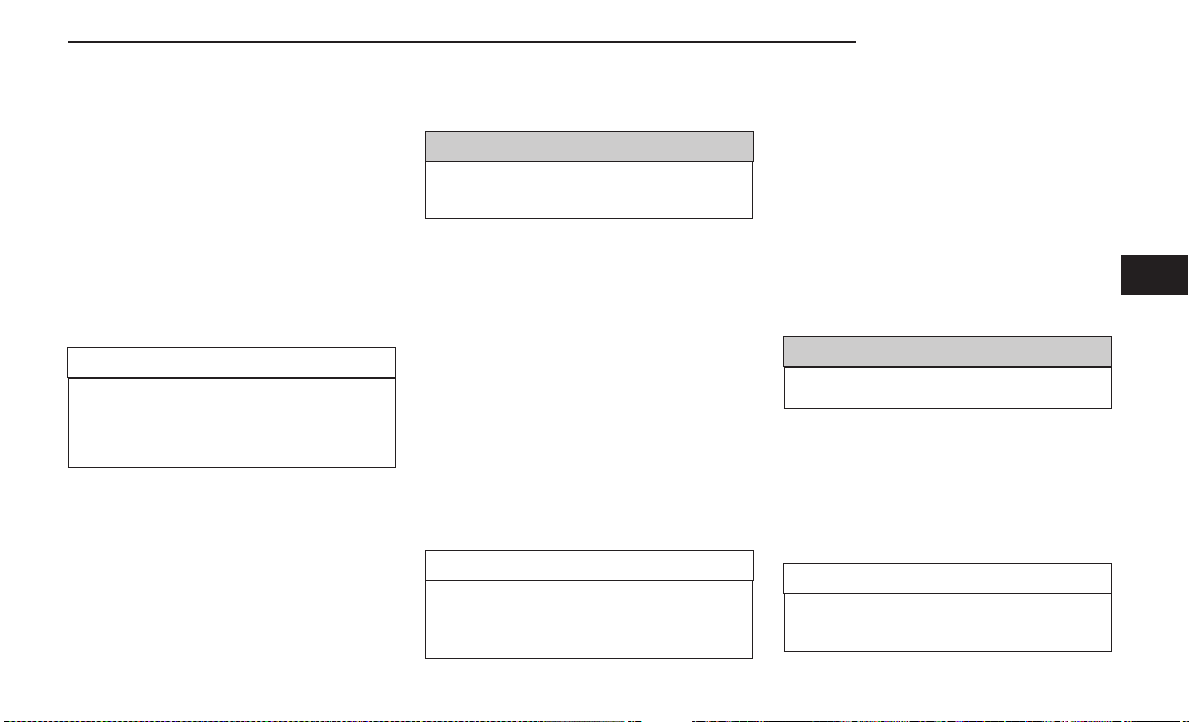Loading ...
Loading ...
Loading ...

SAND
Soft sand is very difficult to travel through with full tire
pressure. When crossing s oft, sandy spots in a trail,
maintain your vehicle's momentum and do not stop.
The key to driving in soft sand is using the appropriate
tire pressure, accelerating slowly, avoiding abrupt
maneuvers and maintaining the vehicle's momentum. If
you are going to be driving on large soft sandy areas or
dunes, reduce your tire pressure to a minimum of
15 psi (103 kPa) to allow for a greater tire surface area.
Reduced tire pressure will drastically improve your trac-
tion and handli ng while driving on the soft sand, but
you must return the tires to normal air pressure before
driving on pavement or other hard surfaces. Be sure
you have a way to reinflate the tires prior to reducing
the pressure.
CAUTION!
Reduced tire pressures may cause tire unseating and
total loss of air pressure. To reduce the risk of tire
unseating, while at a reduce d tire pressur e, reduce
your speed and avoid sharp turns or abrupt
maneuvers.
Crossing Obstacles (Rocks And Other
High Points)
While driving off-road, you will encounter many types of
terrain. These varying types of terrain bring different
types of obstacle s. Before proceeding, review the path
ahead to determine the correct approach and your abil-
ity to safely recover the vehicle if something goes
wrong. Keeping a firm grip on the steering wheel, bri ng
the vehicle to a complete stop and then inch the vehicle
forward until it makes contact with the object. Apply the
throttle lightly while holding a light brake pressure and
ease the vehicle up and over the object.
WARNING!
Crossing obstacles can cau se abrupt steering s ystem
loading which cou ld cause you to lose control of your
vehicle.
USING A SPOTTER
There are many times where it is hard to see the
obstacle or determine the correct path. Determining the
correct path can be extremely di fficult when you are
confronting many obstacles. In these cases have some-
one guide you over, through, or around the obstacle.
Have the person stand a safe distance in front of you
where they can see the o bstacle , watch your tires and
undercarriage, and guide you through.
CROSSING LARGE ROCKS
When approaching large rocks, choose a path which
ensures you drive over the largest of them with your
tires. This will lift your undercarriage over the obst acle .
The tread of the tire is tougher and thicker than the
side wall and is designed to take the abuse. Always look
ahead and make every effort to cross the large rocks
with your tires.
CAUTION!
•
Never attempt to straddle a rock that is large
enough to strike your axles or undercarriage.
•
Never attempt to drive over a rock which is large
enough to contact the door sills.
CROSSING A RAVINE, GULLY, DITCH, WASH-
OUT OR RUT
When crossing a ravine, gully, ditch, washout or a large
rut, the angled approach is the key to maintaining your
vehicle's mobility. Approach these obstacles at a
45-degree angle and let each tire go through the obstacle
independently. You need to use caution when crossing
large obstacles wit h steep sides. Do not attempt to cross
any large obstacle with steep sides at an angle great
enough to put the vehicle at risk of a rollover. If you get
caught in a rut, dig a small trench to the right or lef t at a
45-degree angle ahead of the front tires. Use the removed
dirt to fill the rut ahead of the turnout you just created.
You should now be able to drive out following the trench
you just created at a 45-degree angle.
WARNING!
There is an increased risk of rollover when crossing
an obstacle, at any angle, with steep sides.
CROSSING LOGS
To cross a log, approach it at a slight angle (approximately
10 to 15 degrees). This allows one front tire to be on top
of the log while the other just starts to climb the log. While
climbing the log, modulate your brake and accele rator to
avoid spinning the log out from under your tires. Then
ease the vehicle off the log using your brakes.
CAUTION!
Do not attempt to cross a log with a greater diameter
than the runni ng ground clearance or the vehicle will
become high-centered.
STARTING AND OPERATING 197
4
Loading ...
Loading ...
Loading ...